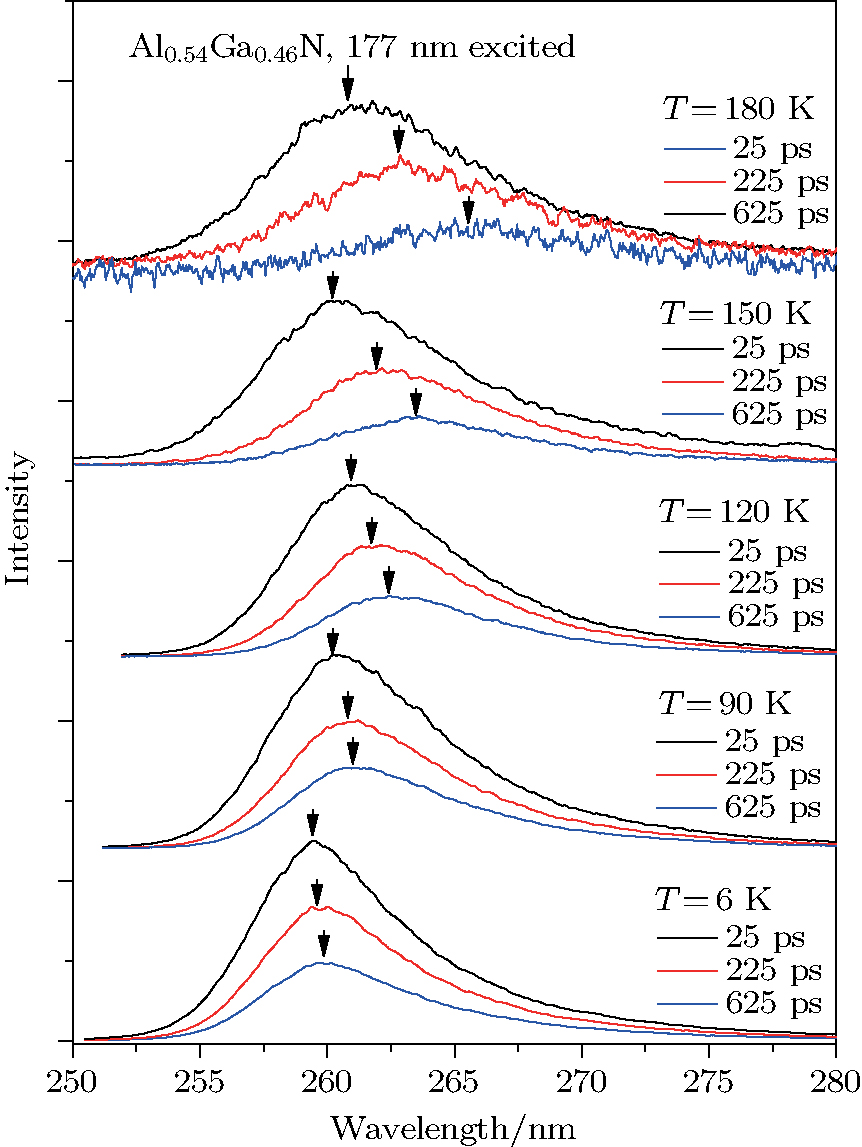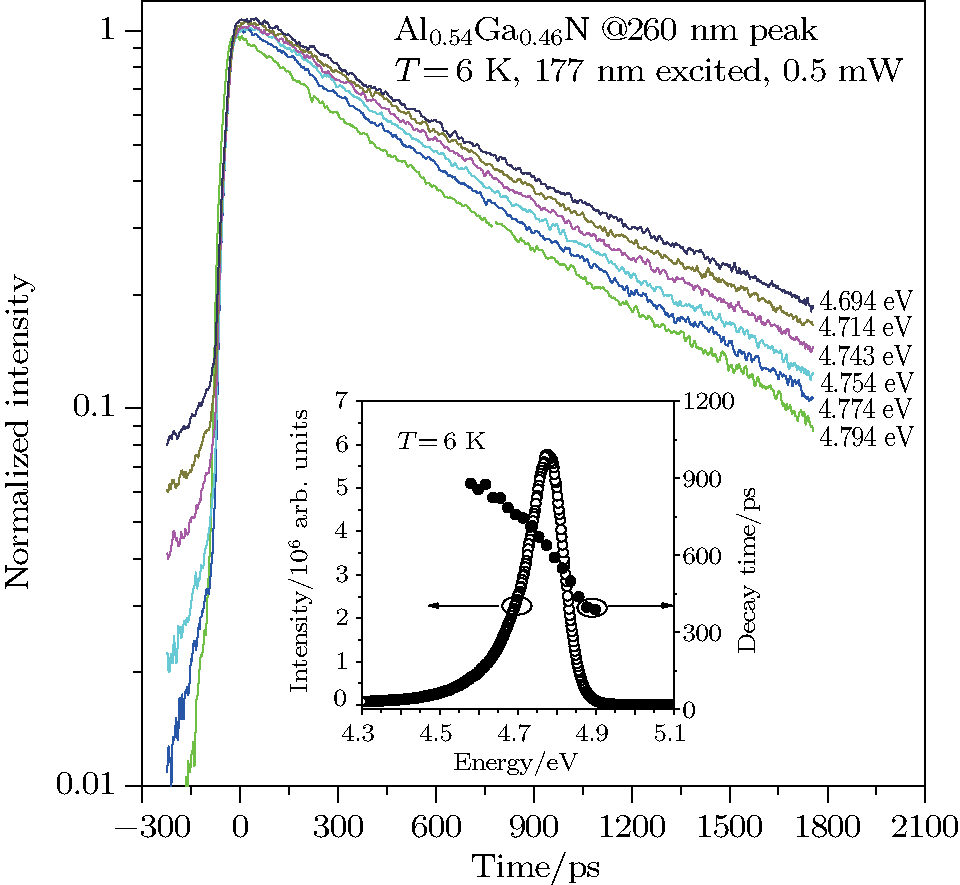1. IntroductionAlGaN ternary compound has attracted much interest due to its wide application in light-emitting devices,[1,2] solar-blind ultraviolet (UV) detectors,[3,4] and high-power and high-temperature electronic devices.[5,6] With the band gap varying from 3.4 eV to 6.2 eV, it is an ideal semiconductor for UV applications, especially light-emitting devices. Although AlGaN light-emitting devices have been made successfully, the AlGaN epilayer suffers from a high density of threading dislocations due to the lattice mismatch and thermal mismatch, which act as nonradiative recombination centers. The nonradiative recombination centers lower the external quantum efficiency of the AlGaN devices. Some researchers[7,8] pointed out that carriers’ localization was favorable for efficient light emission due to preventing the nonequilibrium carriers from reaching the nonradiative recombination centers. Although many researchers[9–13] have reported carriers’ localization induced by potential fluctuations in AlGaN epilayers, the variation of carriers transferring with temperature is not fully understood. A further study of the carriers’ dynamics of the AlGaN alloys is essential, not only for the physical interest but also for the design and the optimization of the device structures.
In this paper, we report temperature-dependent photoluminescence (PL) studies of AlGaN by means of time-integrated PL and time-resolved PL (TRPL). By combining the steady-optical measurement results with temporal response results, localized excitons’ recombination dynamics are analyzed.
3. Results and discussionFigure 1 shows the temperature-dependent PL spectra from 6 K to 240 K. At T =6 K, an asymmetric PL emission at 4.778 eV with a relatively sharp high-energy cutoff and low-energy tail is observed. This transition is due to the recombination of excitons trapped by potential fluctuation at the band edge caused by the random composition distribution. The S-shape temperature-dependent variation of the localized excitons is also shown in Fig. 1, the peak of the localized excitons decreases in the temperature range of 6–120 K, increases for 120–180 K, and decreases again for 180–240 K. This anomalous temperature dependence of the PL peak energy caused by carriers’ localization due to the potential fluctuation is common for the AlGaN epitaxial layer. Similar results have been reported and are well explained by another group.[14]
Figure 2 shows the temporal responses of the PL emission of the Al0.54Ga0.46N epilayer around the peak position of the localized excitons. All of the PL decay curves can be fitted by a single exponential. At the energy range from 4.694 eV to 4.794 eV, the decay time decreases monotonously from 749 ps to 585 ps. The inset exhibits the measured PL decay time as a function of the emission energy at 6 K. We can clearly see that the decay time decreases with increasing emission energy, which is regarded as a hallmark of localized excitons.[12,15] We find that the case is also the same for the high temperature, and the decay time decreases with increasing emission energy at high temperature. At low temperature, radiative recombination is dominant, the carriers are localized in the localized states. On the one hand, compared with the low localized states, the deep localized states provide a stronger constraining effect, the separation of electron and hole wave functions is more serious, and the overlap of the wave functions is smaller, resulting in a weaker oscillator strength of the transition, and the radiative recombination lifetime of the carriers is longer. On the other hand, the high-energy localized excitons decay not only via radiative recombination but also through the additional channel of the transfer process to low-energy states. Thus, at low temperature, the decay time decreases with increasing emission energy. At high temperature, on the one hand, the high-energy localized excitons have lower localized energy, the carriers in the high-energy states can more easily escape from the localized states to free states, compared with the localized states, the overlap of the wave functions is bigger in the free states, resulting in a stronger oscillator strength of the transition, and the radiative recombination lifetime of the carriers is shorter; on the other hand, the nonradiative recombination is dominant at high temperature, compared with the low-energy localized excitons, the high-energy localized excitons are more likely to escape to free states and be captured by the nonradiative recombination centers. As a result, the decay time also decreases with increasing emission energy at high temperature.
In Fig. 3, we present the TRPL spectra of the localized excitons obtained at T = 6 K, 90 K, 120 K, 150 K, and 180 K, respectively. The delay time t =0 is chosen at the position of the maximum intensity in the luminescence temporal responses. In the TRPL spectra, there is a small redshift as the decay time increases at low temperature, and the redshift is enhancing with increasing temperature.
We would like to emphasize that the PL peak has a blueshift from 120 K to 180 K in the time-integrated PL, and the blueshift is attributed to excitons beginning to occupy different higher energy states due to increasing thermal energy.[8,9,14] We previously believed that there would be a blueshift as the decay time increases in the TRPL spectra between 120 K and 180 K, however, in the TRPL spectra, there was no blueshift as the decay time increased. It is an interesting and strange phenomenon.
According to the result reported by Li et al.,[16] carrier transfer time  caused by thermal activation is 22 fs in their InGaN films. Xu et al. has demonstrated that
caused by thermal activation is 22 fs in their InGaN films. Xu et al. has demonstrated that  is 30 fs in their InAs QDs.[17] We have also reported that
is 30 fs in their InAs QDs.[17] We have also reported that  is 83 fs in our previous InAlN film.[18] So we think that carrier transfer time
is 83 fs in our previous InAlN film.[18] So we think that carrier transfer time  is also probably a few tens of fs in this AlGaN sample, although we cannot well fit the
is also probably a few tens of fs in this AlGaN sample, although we cannot well fit the  for this sample due to the irregular S-shape temperature dependence of the peak energy. We believe that the carrier transfer time caused by thermal activation is very fast, it is beyond the detection limit of our detection system, and at the delay time t = 0, the carriers relaxation and transfer have finished. So we cannot observe the blueshift in the TRPL spectra. For
for this sample due to the irregular S-shape temperature dependence of the peak energy. We believe that the carrier transfer time caused by thermal activation is very fast, it is beyond the detection limit of our detection system, and at the delay time t = 0, the carriers relaxation and transfer have finished. So we cannot observe the blueshift in the TRPL spectra. For  , the carriers at various localized states have different decay time. As we have mentioned above, the low-energy localized excitons have longer lifetime than the high-energy localized excitons. So the high-energy localized excitons decay faster, as a result, the peak redshifts as the delay time increases. The enhanced redshift with increasing temperature can be explained as follows: at low temperature, most of the carriers recombine in the low-energy localized states, so there is only a slight redshift. When the temperature increases, part of the carriers transfer from the low-energy localized states to the high-energy localized states, and the distribution of carriers expands. Since the high-energy localized excitons decay faster than the low-energy localized excitons, so the difference of recombination lifetime of carriers at various localized states is larger at high temperature. As a result, the redshift is more prominent as the temperature increases. At higher temperature, nonradiative recombination is dominant, the carriers in the high-energy states are affected by nonradiative recombination and the recombination lifetime is short; meanwhile part of the carriers in the low-energy states may be still in the localized states and have a longer recombination lifetime. Thus, the redshift is most obvious at higher temperature as the decay time increases.
, the carriers at various localized states have different decay time. As we have mentioned above, the low-energy localized excitons have longer lifetime than the high-energy localized excitons. So the high-energy localized excitons decay faster, as a result, the peak redshifts as the delay time increases. The enhanced redshift with increasing temperature can be explained as follows: at low temperature, most of the carriers recombine in the low-energy localized states, so there is only a slight redshift. When the temperature increases, part of the carriers transfer from the low-energy localized states to the high-energy localized states, and the distribution of carriers expands. Since the high-energy localized excitons decay faster than the low-energy localized excitons, so the difference of recombination lifetime of carriers at various localized states is larger at high temperature. As a result, the redshift is more prominent as the temperature increases. At higher temperature, nonradiative recombination is dominant, the carriers in the high-energy states are affected by nonradiative recombination and the recombination lifetime is short; meanwhile part of the carriers in the low-energy states may be still in the localized states and have a longer recombination lifetime. Thus, the redshift is most obvious at higher temperature as the decay time increases.
Figure 4 presents the temperature responses of the localized excitons recombination at the spectral peak position from 6 K to 240 K. The inset shows the PL decay curves at various temperatures. From 6 K to 120 K, the PL decay curves can be described well by a single exponential. At  K, by getting rid of the laser scattering effect, the PL decay curves can still be fitted by a single exponential. Then we obtain the lifetime of the localized excitons at various temperatures, as depicted in Fig. 4. We observe an interesting phenomenon that the lifetime increases with temperature according to
K, by getting rid of the laser scattering effect, the PL decay curves can still be fitted by a single exponential. Then we obtain the lifetime of the localized excitons at various temperatures, as depicted in Fig. 4. We observe an interesting phenomenon that the lifetime increases with temperature according to  between 6 K and 90 K. As we all know, the radiative recombination lifetime of three-dimensional (3D) excitons increases with temperature according to
between 6 K and 90 K. As we all know, the radiative recombination lifetime of three-dimensional (3D) excitons increases with temperature according to  , while the radiative recombination lifetime of two-dimensional (2D) excitons is proportional to the temperature T.[19–21] The results indicate that in this temperature range, radiative recombination is dominant; what is more, the localized excitons in our experiment behave more similarly to 2D excitons rather than 3D excitons. In other words, the carriers are partly trapped like being confined in quantum wells. For
, while the radiative recombination lifetime of two-dimensional (2D) excitons is proportional to the temperature T.[19–21] The results indicate that in this temperature range, radiative recombination is dominant; what is more, the localized excitons in our experiment behave more similarly to 2D excitons rather than 3D excitons. In other words, the carriers are partly trapped like being confined in quantum wells. For  , the lifetime decreases sharply as the temperatures increases; this is due to the enhanced impact of nonradiative recombination.
, the lifetime decreases sharply as the temperatures increases; this is due to the enhanced impact of nonradiative recombination.


















